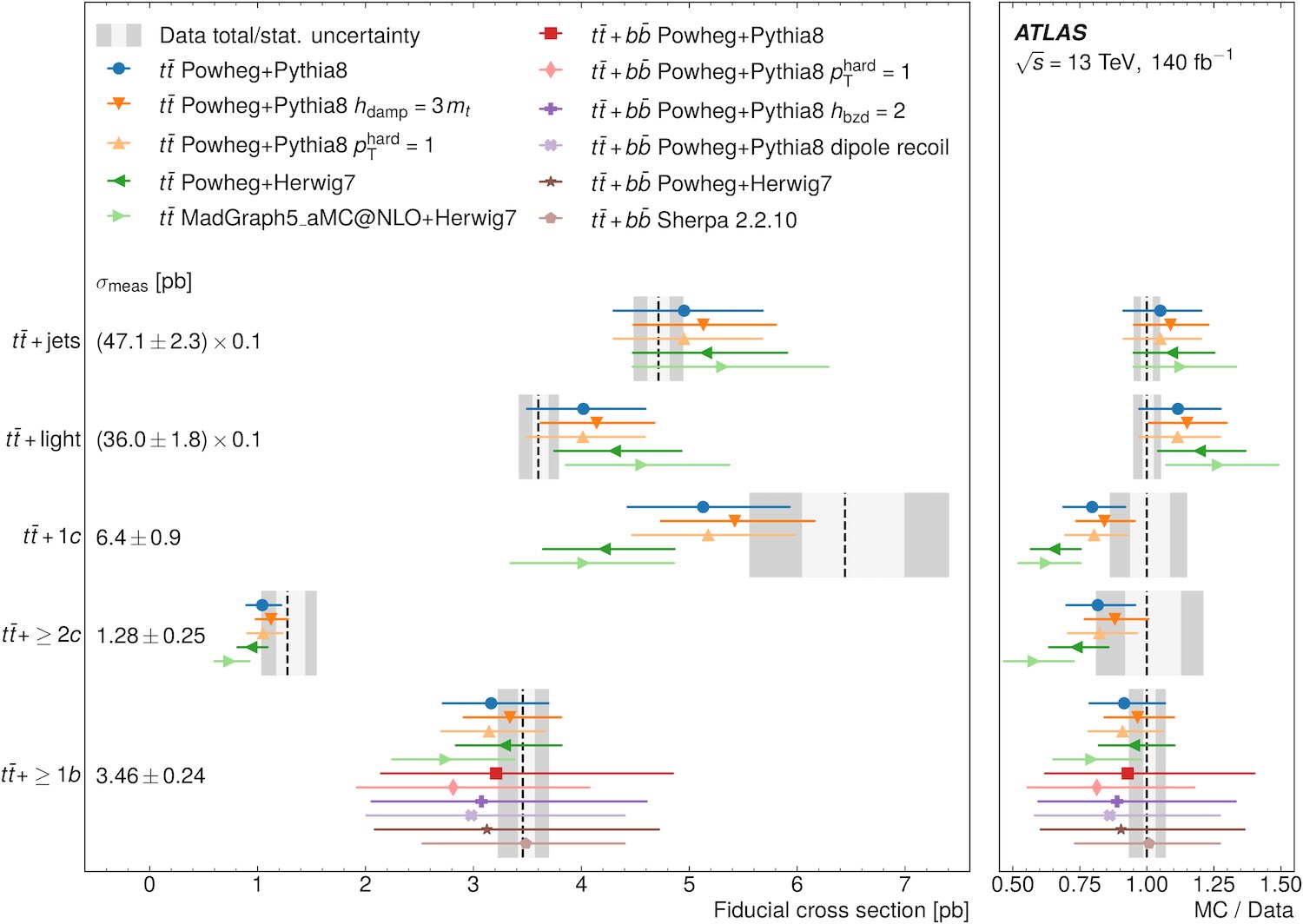In the intricate world of particle physics, the top quark stands out as the most massive elementary particle known. Its unique properties make it a powerful probe for testing the Standard Model and searching for new physics. At the Large Hadron Collider (LHC) at CERN, experiments like ATLAS meticulously study top-quark production in various forms. One particularly challenging, yet crucial, area of research involves top-quark pairs produced in association with additional heavy-flavour quarks, specifically charm (c) quarks.
This new measurement from the ATLAS Collaboration, published in Physics Letters B, marks a significant milestone: the first dedicated ATLAS measurement of top-quark pair production in association with charm quarks (tt̄ + charm). I had the pleasure of presenting this result first at the TOP 2024 conference. This process is of paramount importance because it forms a substantial background to searches for rare Standard Model processes, such as the production of top-quark pairs with Higgs bosons decaying to bottom quarks (tt̄H(bb̄)), and even the elusive four-top-quark production (tt̄tt̄). Understanding and precisely measuring tt̄ + charm production is therefore essential for unlocking the full discovery potential of the LHC.
Bottom (b) quarks have been extensively studied in association with top quarks (tt̄ + ≥1 b), and charm quarks present an equally unique challenge. Their production mechanisms are complex, involving gluon radiation that splits into charm-anticharm pairs, or charm quarks originating directly from the initial state. These processes can lead to final states with one or more charm jets, making them difficult to distinguish from other phenomena.
We addressed this complexity by separately determining the production rates of tt̄ + two or more charm jets (tt+≥2c) and tt̄ + one charm jet (tt+1c). This distinction is vital as these processes are sensitive to different underlying production mechanisms. We analyzed the full LHC Run 2 dataset, corresponding to an integrated luminosity of 140 fb⁻¹, considering events with one or two charged leptons in the final state. These leptonic decay channels of the top quarks provide cleaner signatures for analysis.
 Figure: Feynman diagrams illustrating representative production modes of top-quark pairs with additional charm quarks. (Image: ATLAS Collaboration/CERN)
Figure: Feynman diagrams illustrating representative production modes of top-quark pairs with additional charm quarks. (Image: ATLAS Collaboration/CERN)
A Novel Approach to Charm Tagging
To accurately identify and categorize events with charm quarks, we developed a custom flavour-tagging algorithm called the b/c-tagger. This specialized tool is designed for the simultaneous identification of both charm and bottom jets, allowing us to define analysis regions that are highly sensitive to tt+1c and tt+≥2c production. This innovative approach is key to disentangling the complex heavy-flavour landscape in top-quark events.
The b/c-tagger leverages advanced techniques to distinguish jets originating from charm quarks from those produced by bottom quarks or lighter quarks and gluons. This capability is crucial for reducing backgrounds and isolating the tt̄ + charm signal. By applying this tagger, we were able to define fiducial phase spaces – specific regions of the detector’s acceptance – where we could precisely measure the production rates of tt+1c and tt+≥2c.
Beyond absolute production rates, we also extracted the ratios of tt+1c, tt+≥2c, and tt̄ + b-jets to the overall tt̄ + jets production. These ratios provide valuable insights into the relative contributions of different heavy-flavour production mechanisms and allow for more detailed comparisons with theoretical predictions from next-to-leading order + parton-shower simulations.
Results: Unveiling the Charm Signatures
Our analysis involved meticulously selecting events with one or two leptons and then applying the b/c-tagger to categorize jets based on their heavy-flavour content. This allowed us to define distinct analysis regions sensitive to tt+1c and tt+≥2c production. The measured production rates were then compared with predictions from various Monte Carlo simulations.
The results provide valuable insights into the complex interplay of top quarks and charm quarks. We found that the measured production rates are systematically higher than theoretical predictions from all tested Monte Carlo simulations. While the measurements remain broadly consistent within uncertainties, their precision enables a more refined comparison and places tighter constraints on theoretical modelling. This is particularly important for processes where charm quarks are produced through gluon splitting, a challenging aspect to model accurately in Quantum Chromodynamics.
 Figure: Measured fiducial cross-sections for top-quark pair production with additional charm jets compared to various simulations. (Image: ATLAS Collaboration/CERN)
Figure: Measured fiducial cross-sections for top-quark pair production with additional charm jets compared to various simulations. (Image: ATLAS Collaboration/CERN)
Conclusion: A New Era for Top-Quark Physics
This first dedicated measurement of top-quark pair production in association with charm quarks by the ATLAS Collaboration is a significant achievement. By developing and deploying the b/c-tagger, we have opened new avenues for exploring complex final states involving charm quarks and provided high-quality experimental data that will directly influence both theory and experiment.
The implications are far-reaching:
- Enhanced precision for rare processes: A more accurate understanding of tt̄ + charm production improves the sensitivity of searches for rare Standard Model processes such as tt̄H(bb̄) and four-top-quark production, where it constitutes a major background.
- Refined theoretical models: Our measurements serve as stringent tests for calculations of tt̄ + heavy-flavour production, reducing uncertainties and improving the reliability of predictions.
- Path to future discoveries: With a better handle on tt̄ + charm production, we are paving the way for more sensitive investigations into processes like tt̄H(cc̄), as well as more precise studies at the High-Luminosity LHC.
In summary, this work represents a vital step forward in understanding heavy-flavour production in top-quark events and sets the stage for exciting developments in the years to come.
For more details, you can refer to the ATLAS Physics Briefing on this result.
Publication:
Author: ATLAS Collaboration.
Title: Measurement of top-quark pair production in association with charm quarks in proton-proton collisions at √s = 13 TeV with the ATLAS detector.
Reference: Phys. Lett. B 860 (2025) 139177.
DOI:10.1016/j.physletb.2024.139177
|
arXiv:2409.11305.